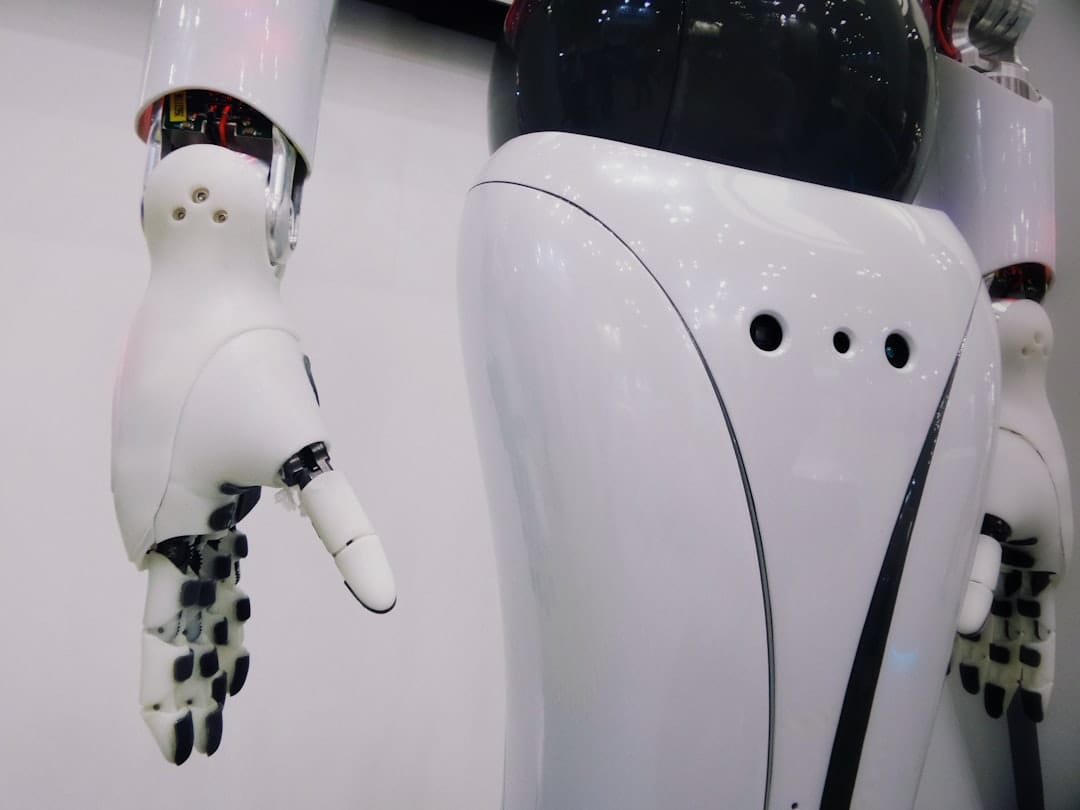Why Agentic AI is the Next Frontier in Technology.
Artificial intelligence has undergone a remarkable evolution over the past decade, transforming from simple rule-based systems to sophisticated models capable of generating content, recognizing...

Artificial intelligence has undergone a remarkable evolution over the past decade, transforming from simple rule-based systems to sophisticated models capable of generating content, recognizing patterns, and making predictions. However, we now stand at the precipice of the next great revolution in AI development: the rise of agentic AI. Unlike traditional AI systems that passively respond to queries or perform specific tasks within narrow parameters, agentic AI possesses the capability to operate with greater autonomy, take initiative, and interact with the world in ways that more closely resemble human agency.
This shift represents more than just an incremental improvement in AI capabilities - it signals a fundamental reimagining of how artificial intelligence will integrate into business operations and society at large. As organizations increasingly recognize the limitations of current AI implementations, the promise of systems that can independently pursue goals, adapt to changing circumstances, and make decisions without constant human oversight becomes increasingly compelling.
What Exactly is Agentic AI?
Agentic AI refers to artificial intelligence systems designed to act as autonomous agents capable of perceiving their environment, making decisions, and taking actions to achieve specific goals with minimal human intervention. Unlike conventional AI models that excel at pattern recognition or prediction within predefined frameworks, agentic AI systems possess a degree of autonomy that allows them to navigate complex, dynamic environments.
The key characteristics that distinguish agentic AI include:
1. Goal-oriented behavior: Agentic systems pursue specific objectives rather than simply responding to prompts.
2. Environmental awareness: These systems can perceive and interpret their surroundings, whether digital or physical.
3. Decision-making capability: Agentic AI can evaluate options and select courses of action independently.
4. Adaptability: The ability to adjust strategies based on changing conditions or new information.
5. Persistence: Agentic systems maintain focus on long-term objectives despite obstacles or distractions.
This combination of features enables agentic AI to transcend the limitations of traditional AI implementations, which typically require explicit programming for each specific task and struggle to generalize beyond their training data.
The Evolution from Predictive to Agentic AI
To appreciate the revolutionary nature of agentic AI, it's helpful to understand the evolutionary path that has led to this point. AI development has progressed through several distinct phases:
Rule-Based Systems (1950s-1980s)
The earliest AI systems relied on explicitly programmed rules and logic. These expert systems excelled at specific, well-defined tasks but lacked flexibility and required extensive human effort to create and maintain.
Machine Learning (1990s-2010s)
The machine learning revolution introduced systems that could learn patterns from data rather than following explicit rules. This dramatically expanded AI's capabilities but still required significant human intervention in data preparation, feature engineering, and model selection.
Deep Learning (2010s-Present)
Deep neural networks enabled AI to process unstructured data like images, speech, and text at unprecedented scales. This led to breakthroughs in natural language processing, computer vision, and other domains, but these systems remained fundamentally reactive rather than proactive.
Agentic AI (Emerging)
The current frontier involves systems that combine the pattern recognition capabilities of deep learning with decision-making frameworks that enable autonomous action. Rather than simply processing inputs to generate outputs, agentic AI actively engages with its environment to achieve objectives.
This progression reflects a fundamental shift in how we conceptualize artificial intelligence—from tools that augment human capabilities to partners that can take initiative and operate independently when appropriate.
Why Agentic AI Represents a Paradigm Shift
The transition to agentic AI isn't merely a technical evolution; it represents a paradigm shift in how businesses and society will interact with artificial intelligence. Several factors make this development particularly significant:
From Reactive to Proactive Intelligence
Traditional AI systems operate reactively—they respond when prompted but lack the capability to initiate action independently. Agentic AI, by contrast, can identify opportunities, anticipate problems, and take preemptive measures without waiting for human instruction. This shift from reactive to proactive operation dramatically expands the potential applications and value of AI.
Breaking Free from Narrow AI
Most current AI implementations are examples of "narrow AI"—systems designed to excel at specific tasks but unable to transfer their capabilities to new domains. Agentic AI moves closer to the long-sought goal of artificial general intelligence (AGI) by incorporating planning, reasoning, and adaptability that allow systems to navigate unfamiliar situations effectively.
Redefining Human-AI Collaboration
As AI becomes more autonomous, the nature of human-AI collaboration evolves. Rather than requiring constant direction and supervision, agentic systems can function as true collaborators that handle routine decisions independently while escalating complex issues that require human judgment. This fundamentally changes the relationship between humans and machines in the workplace.
Enabling New Business Models
The capabilities of agentic AI open possibilities for entirely new business models and service offerings that were previously impractical or impossible. From personalized digital assistants that proactively manage schedules and communications to autonomous systems that optimize complex business processes, agentic AI enables innovations that transcend the limitations of traditional approaches.
Real-World Applications Emerging Today
While fully realized agentic AI remains an evolving technology, early implementations are already demonstrating the potential of this approach across various industries:
Autonomous Research Assistants
Researchers at leading institutions are developing AI systems that can independently design and conduct experiments, analyze results, and propose follow-up investigations. These systems accelerate the pace of scientific discovery by handling routine aspects of the research process while allowing human scientists to focus on creative problem-solving and interpretation.
Financial Management Agents
In the financial sector, agentic AI systems monitor market conditions, evaluate investment opportunities, and execute trades based on predefined strategies and risk parameters. These systems can respond to market changes in milliseconds while continuously learning from outcomes to refine their approaches.
Customer Service Orchestrators
Advanced customer service platforms now employ agentic AI to manage end-to-end customer interactions. These systems can identify customer needs, access relevant information across disparate systems, initiate appropriate actions, and follow through to ensure resolution—all while maintaining a coherent conversation with the customer.
Supply Chain Optimization
Agentic AI is transforming supply chain management by autonomously monitoring inventory levels, anticipating demand fluctuations, adjusting procurement schedules, and coordinating logistics to optimize efficiency and resilience. These systems can respond dynamically to disruptions and identify opportunities for improvement that might escape human analysts.
Healthcare Coordination
In healthcare settings, agentic AI systems help coordinate patient care by monitoring treatment plans, scheduling follow-up appointments, tracking medication adherence, and alerting healthcare providers to potential issues. This comprehensive approach improves outcomes while reducing the administrative burden on medical professionals.
These examples represent just the beginning of what's possible as agentic AI matures and becomes more widely deployed across industries.
The Technical Foundations Enabling Agentic AI
The emergence of agentic AI has been made possible by convergent advances in several key technical domains:
Large Language Models as Foundation
Large language models (LLMs) like GPT-4 provide a crucial foundation for agentic AI by enabling sophisticated natural language understanding and generation. These capabilities allow agentic systems to interpret complex instructions, reason about abstract concepts, and communicate effectively with humans and other systems.
Reinforcement Learning from Human Feedback
Techniques like reinforcement learning from human feedback (RLHF) enable AI systems to align their behavior with human preferences and values. This approach helps address the challenge of specifying complex goals and constraints in ways that produce desirable outcomes while avoiding harmful side effects.
Multi-Agent Systems
Research in multi-agent systems explores how multiple AI agents can coordinate their activities to solve problems that would be difficult or impossible for individual agents. These approaches provide frameworks for decomposing complex tasks and managing the interactions between specialized components.
Tool Use and API Integration
Modern agentic AI systems can leverage external tools and APIs to extend their capabilities beyond their core models. This ability to access specialized functionality—from web searches and code execution to database queries and external services—dramatically expands what these systems can accomplish.
Planning and Reasoning Frameworks
Advanced planning algorithms enable agentic AI to formulate multi-step strategies for achieving goals, evaluating potential approaches, anticipating obstacles, and adapting plans as circumstances change. These capabilities are essential for effective autonomous operation in complex environments.
The integration of these technologies creates systems that can perceive, reason, plan, and act with unprecedented sophistication and autonomy.
Challenges and Considerations in Agentic AI Adoption
Despite its transformative potential, the path to widespread agentic AI adoption faces several significant challenges:
Safety and Alignment
As AI systems become more autonomous, ensuring they reliably pursue intended goals while avoiding harmful actions becomes increasingly critical. Developing robust methods for specifying objectives, constraining behavior, and maintaining human oversight remains an active area of research.
Transparency and Explainability
Agentic systems that make independent decisions raise important questions about transparency and accountability. Organizations deploying these technologies must consider how to make the reasoning behind AI actions understandable to users, regulators, and other stakeholders.
Legal and Regulatory Frameworks
Existing legal frameworks were not designed with autonomous AI agents in mind, creating uncertainty around liability, intellectual property, privacy, and other critical issues. Developing appropriate regulations that balance innovation with protection against potential harms represents a significant challenge.
Economic and Workforce Impacts
As agentic AI automates increasingly complex cognitive tasks, organizations must thoughtfully manage the transition to ensure these technologies augment human capabilities rather than simply displacing workers. This requires investment in training, reskilling, and creating new roles that leverage uniquely human strengths.
Ethical Considerations
The deployment of autonomous systems raises profound ethical questions about agency, responsibility, fairness, and the appropriate limits of automation. Organizations must engage with these issues proactively rather than treating them as afterthoughts.
Addressing these challenges will require collaboration between technologists, business leaders, policymakers, and representatives from diverse communities affected by these technologies.
How Organizations Can Prepare for the Agentic AI Revolution
As agentic AI continues to mature, forward-thinking organizations can take several steps to position themselves for success in this new landscape:
Develop an Agentic AI Strategy
Begin by assessing how agentic AI could impact your industry and specific business operations. Identify high-potential application areas where autonomous systems could create significant value, and develop a strategic roadmap for exploration and implementation.
Invest in Foundational Capabilities
Build the technical infrastructure, data resources, and organizational expertise needed to support agentic AI initiatives. This includes developing proficiency with relevant technologies like LLMs, reinforcement learning, and multi-agent systems.
Start with Hybrid Approaches
Rather than attempting to deploy fully autonomous systems immediately, begin with hybrid approaches that combine AI capabilities with human oversight and intervention. This allows organizations to gain experience with agentic technologies while maintaining appropriate controls.
Establish Governance Frameworks
Develop robust governance processes for evaluating, deploying, and monitoring agentic AI systems. These frameworks should address risk management, ethical considerations, transparency requirements, and mechanisms for human oversight.
Foster Cross-Disciplinary Collaboration
Successful agentic AI implementation requires collaboration between technical experts, domain specialists, ethicists, legal advisors, and business strategists. Create structures that facilitate this cross-disciplinary interaction and ensure diverse perspectives inform development efforts.
Engage with the Broader Ecosystem
Participate in industry consortia, academic partnerships, and policy discussions related to agentic AI. These engagements provide access to cutting-edge research, emerging best practices, and opportunities to shape the evolving regulatory landscape.
Organizations that take these preparatory steps will be better positioned to capture value from agentic AI while managing associated risks and challenges.
The Future Landscape of Agentic AI
Looking ahead, several emerging trends will likely shape the evolution of agentic AI in the coming years:
Increasing Autonomy and Sophistication
Agentic AI systems will continue to grow more capable and autonomous, handling increasingly complex tasks with less human supervision. This progression will gradually expand the domains where AI can operate effectively without direct human guidance.
Specialized vs. General-Purpose Agents
The field will likely develop along two parallel tracks: highly specialized agents optimized for specific domains and more general-purpose systems capable of operating across diverse contexts. Each approach offers distinct advantages for different applications.
Collaborative Human-AI Ecosystems
Rather than viewing AI as either replacing humans or serving as passive tools, future systems will establish more nuanced collaborative relationships where humans and AI agents each contribute their unique strengths to achieve shared objectives.
Democratization of Agent Creation
As the underlying technologies mature, creating custom AI agents will become more accessible to non-specialists through simplified interfaces, pre-built components, and agent development platforms. This democratization will accelerate innovation and diversify applications.
Emergence of Agent Economies
Networks of specialized AI agents interacting with each other and with human participants will create new economic structures and business models. These "agent economies" may develop novel forms of collaboration, competition, and value exchange.
Regulatory Frameworks and Standards
Governments and industry bodies will establish more comprehensive frameworks for governing agentic AI, addressing issues of safety, liability, privacy, and ethical use. These regulations will significantly influence how the technology develops and is deployed.
Organizations that anticipate these trends can position themselves to capitalize on the opportunities while navigating the challenges that lie ahead.
Conclusion
Agentic AI represents the next frontier in artificial intelligence—a fundamental shift from systems that passively respond to instructions to autonomous agents that can perceive, decide, and act in pursuit of defined goals. This transition opens unprecedented possibilities for innovation, efficiency, and value creation across industries while raising important questions about control, responsibility, and the evolving relationship between humans and machines.
As with previous technological revolutions, the organizations that thrive in this new landscape will be those that thoughtfully engage with these technologies—understanding both their transformative potential and the challenges they present. By developing clear strategies, investing in foundational capabilities, establishing appropriate governance frameworks, and fostering cross-disciplinary collaboration, forward-thinking businesses can harness the power of agentic AI while managing associated risks.
The journey toward truly agentic AI has only just begun, but its trajectory is clear. The coming decade will witness remarkable advances in artificial intelligence's ability to operate autonomously in complex environments, fundamentally reshaping how businesses operate and how humans interact with technology. For those prepared to embrace this future, the opportunities are extraordinary.



